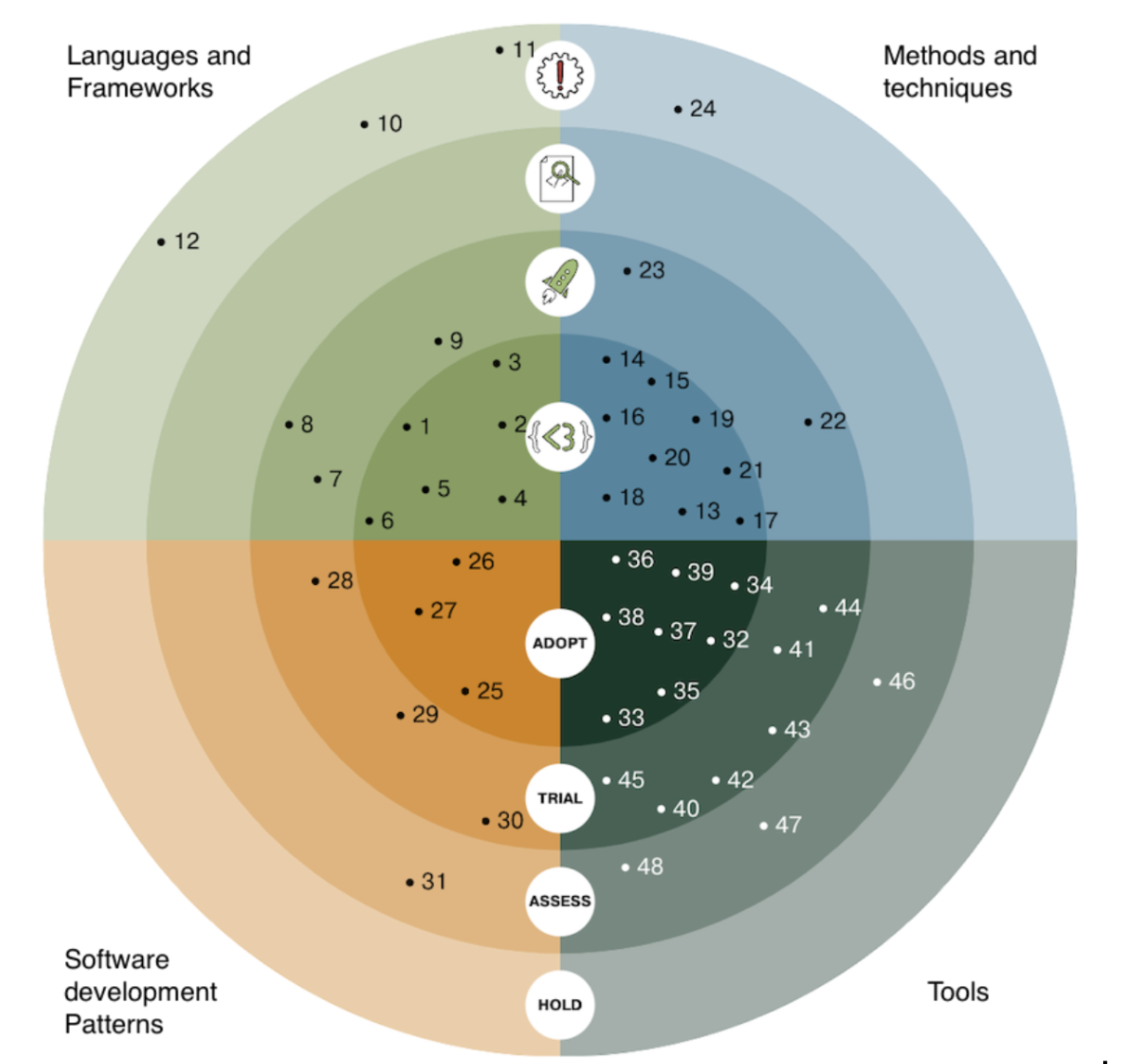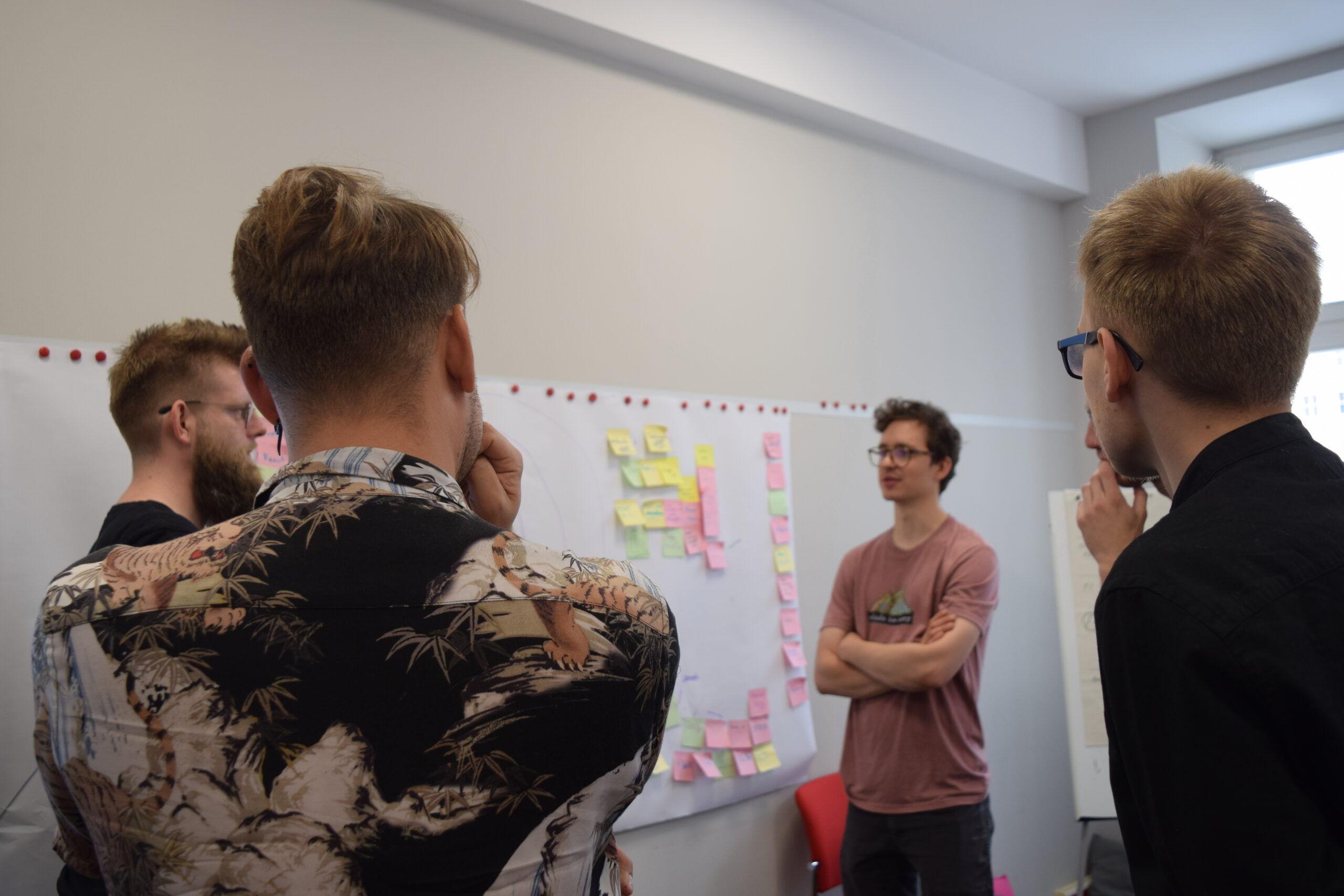
A Deep Dive into Kiwee Technology Radar Creation
Ornela MyftariReading Time: 5 minutes
What is Technology Radar?
Technology Radar is a visual representation of expert opinions on technologies to track and assess emerging technologies, methods, and practices. The concept of a Technology Radar was introduced and popularized by ThoughtWorks. Dive into the birth of ThoughtWorks' Technology Radar.
This tool tracks a list of technologies called blips. The blips are organized into a radar using two categorizing elements: the quadrants and the rings.
The quadrants are a categorization of the types of blips, such as:
- Languages and Frameworks
- Methods and Techniques
- Tools
- Software development patterns
The blip list is complemented by an assessment result called a ring assignment. Rings indicate the blip's maturity and utility.
The rings are:
- Adopt - This ring represents technologies or practices that we recommend adopting and are proven to be highly beneficial for our organization
- Trial - Technologies or practices in this ring show great promise and we encourage further exploration and experimentation.
- Asses - While these technologies are promising, they need a deeper study so we suggest investigating and using them in an appropriate context
- Hold - Technologies or practices in this ring may have potential but we recommend thinking twice before adoption.
The numbers inside the quadrants are associated with the blips.

A visual representation of the radar
What inspired us?
At Kiwee, we are passionate about technology. We develop, research, commit to open source, and constantly aim to improve. We like to help others by sharing what we know on social media and writing articles on our website, but we also learn from other people's experiences.
Thoughtworks inspired us with their Technology Radar, so we built our first in 2019.
Our first Technology Radar had 20 blips, and we missed a few things. It wasn't perfect, but we've just iterated on it and will continue improving.
We based our Technology Radar on this open-source repository from AOE. They built their own Technology Radar and decided to share their code so other companies could build their own.
Through Technology Radar, we wanted to create a vision of where our organization is going with technology.
How did we build it?
As a fully remote team, we embraced the opportunity to develop our Technology Radar using a hybrid approach. During our 1- week company gathering in Wrocław, we organized face-to-face sessions, leveraging the benefits of both in-person and virtual collaboration. Having previously operated as a hybrid company before the pandemic, we aimed to strategically integrate the strengths of office work and remote work. We always want to get an objective assessment across our entire technology portfolio and try to assess what works well and what does not in order to understand how we consume technology. A brainstorming session was a good starting point.
A comprehensive review of existing blips
The first step of our intensive Technology Radar session kicked off with a comprehensive review. Our entire team gathered around the board, where we drew circles and quarters and delved into discussions about the prior volume's blips.

Brainstorming session photo
Each team member shared their insights into the blips: whether they had been applied, the nature of projects they had been used in, and an evaluation of their effectiveness and maturity. The central question was, are these blips worth preserving? If not, what's the rationale behind their removal? After further consideration, we pondered over crucial decisions, such as relocating some of the existing blips and completely removing others.
Addition of new blips
After discussing the prior volume's blips, the next step was individually adding new blips using Post-it notes. Each team member identified the new blips that aligned with our organization's goals and challenges and added them to the board.
By the end of the session, our board was covered in a colorful assortment of Post-it notes, and we moved on to another vital step: the assessment of each blip.
In-depth assessment of blips
Assessing a blip entailed a deep dive into its potential use cases within our organization. We engaged in thoughtful discussions, carefully considering the specific problems each blip could solve.
We weighed the benefits it might offer and examined the potential risks and challenges associated with its implementation. Maturity was another vital aspect of our assessment. We evaluated the maturity level of each blip, determining whether it was in its early stages, actively evolving, or already adopted across the tech industry. The adoption rate of the blip was an important factor.
Placement of the blips
Based on the feedback and insights gathered, the next step involved deciding where each blip belonged on our Technology Radar. Rings are what generate the most dynamic discussion. It was a moment for consensus-building as we determined whether a particular blip should move to trial, be assessed, be put on hold, be adopted, or undergo further evaluation before being included.
After everything fell into place and a consensus was reached, we assigned owners to each blip so that a description would be prepared. These selections were made collaboratively among team members.
Digitalization and Execution
The next step was to digitize all our discussions and materials in Miro and Confluence to ensure a structured workflow.
Each blip's description was converted into a task and assigned to its corresponding owner. With task assignments in place, the team set to work on the blip descriptions asynchronously, allowing them the time to reflect and incorporate their individual opinions. A new branch was created for each blip in our repository, and reviewers were assigned. This process ensured that blip descriptions would only be accepted with the confirmation of other team members.
Over the course of six months, our dedicated team invested around 700 hours in crafting the Technology Radar that aligns with our organizational goals. The timeframe accounts for thorough research, brainstorming sessions, development, testing, and ensuring it meets our standards. When writing the content for the Technology Radar, the team followed the Microsoft Style Guide to ensure our writing style was consistent.
The newest volume is now up to date on our website, Technology Radar Volume 2.
Why aren’t certain technologies on our Technology Radar?
If you are curious about why certain well-known technologies didn't make it onto our Technology Radar, there are several reasons:
- No team member recommended the blip.
- While it might be an interesting technology, we prioritized other blips that we found more compelling or relevant to our current focus.
- The blips were already included in the prior volume.
- We included them within a broader technological concept.
- Our team has yet to have the opportunity to work with this technology directly, and as such, we couldn't provide a well-informed opinion or recommendation about it.
How do we maintain it?
Up to this point, we've introduced two iterations of our Technology Radar, and on both occasions, we opted for face-to-face sessions. Our rationale behind this choice is grounded in the remarkable effectiveness and collaborative spirit fostered by this approach.
We aim to keep track of new technologies and techniques we want to use. Every year, we would like to gather, review, and publish the next Technology Radar volume. We're still researching and working on making the Technology Radar maintenance process easier. Stay tuned for updates on our progress!
Summary
In conclusion, Technology Radar is not merely a tool; it's a manifestation of our commitment to staying at the forefront of technology. Building our Technology Radar was no small feat. It involved intensive brainstorming sessions, in-depth assessments, and thoughtful discussions among our team members.
Each blip on the Technology Radar represents a potential game-changer. We took great care in evaluating their suitability, maturity, and relevance to reflect a careful selection of technologies that align with our organization's vision and challenges. We are proud of the result, an up-to-date Technology Radar that can be found on our website.
In the world of technology, adaptability is crucial for sustained success. Our Technology Radar serves as a strategic tool to harness new technologies effectively, ensuring a more promising future.


